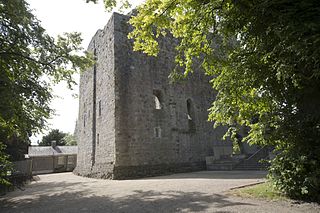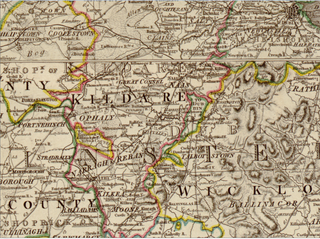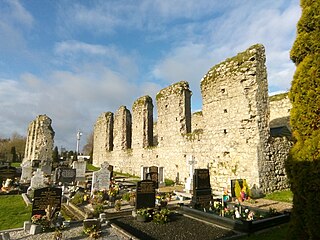
Duke of Leinster is a title in the Peerage of Ireland and the premier dukedom in that peerage. The subsidiary titles of the Duke of Leinster are: Marquess of Kildare (1761), Earl of Kildare (1316), Earl of Offaly (1761), Viscount Leinster, of Taplow in the County of Buckingham (1747), Baron of Offaly, Baron Offaly (1620) and Baron Kildare, of Kildare in the County of Kildare (1870). The viscounty of Leinster is in the Peerage of Great Britain, the barony of Kildare in the Peerage of the United Kingdom, and all other titles in the Peerage of Ireland. The courtesy title of the eldest son and heir of the Duke of Leinster is Marquess of Kildare. The Duke of Leinster is the head of the House of Kildare.

Athy is a market town at the meeting of the River Barrow and the Grand Canal in south-west County Kildare, Ireland, 72 kilometres southwest of Dublin. A population of 9,677 makes it the sixth largest town in Kildare and the 50th largest in the Republic of Ireland, with a growth rate of approximately 60 per cent since the 2002 census.

The FitzGerald dynasty is a noble and aristocratic dynasty of Cambro-Norman and Anglo-Norman origin. They have been peers of Ireland since at least the 13th century, and are described in the Annals of the Four Masters as having become "more Irish than the Irish themselves" or Gaels, due to assimilation with the native Gaelic aristocratic and popular culture. The dynasty has also been referred to as the Geraldines and Ireland's largest landowners. They achieved power through the conquest of large swathes of Irish territory by the sons and grandsons of Gerald de Windsor. Gerald de Windsor was the first Castellan of Pembroke Castle in Wales, and became the male progenitor of the FitzMaurice and FitzGerald Dynasty. His father, Baron Walter FitzOther, was the first Constable and Governor of Windsor Castle for William the Conqueror, and was the Lord of 38 manors in England, making the FitzGeralds one of the "service families" on whom the King relied for his survival.

Kilkea Castle is located 5 km (3.1 mi) northwest of Castledermot, County Kildare, Ireland near the village of Kilkea on the R418 regional road from Athy to Tullow. It was a medieval stronghold, for over 700 years, of the Fitzgeralds, earls of Kildare.
The Battle of Skerries, also named the Battle of Ardscull, was a battle in the Bruce campaign in Ireland – part of the First War of Scottish Independence – fought on 26 January 1316, resulting in a Scottish victory. It was part of the Irish campaign of Edward Bruce, brother of Robert Bruce, king of Scotland. The site of the battle was Skerries near Ardscull in County Kildare.
Gerald FitzMaurice FitzGerald, 5th Earl of Kildare was an Irish peer. Gerald was the son of Maurice FitzGerald, 4th Earl of Kildare and Elizabeth Burghersh.

Thomas FitzJohn FitzGerald, 7th Earl of Kildare, was an Irish peer and statesman of the fifteenth century who held the office of Lord Chancellor of Ireland.

Conna Castle is a 16th century tower house located near Conna in County Cork, Ireland.

The High Sheriff of Kildare was the British Crown's judicial representative in County Kildare, Ireland from the 16th century until 1922, when the office was abolished in the new Free State and replaced by the office of Kildare County Sheriff. The High Sheriff had judicial, electoral, ceremonial and administrative functions and executed High Court Writs. In 1908, an Order in Council made the Lord Lieutenant the Sovereign's prime representative in a county and reduced the High Sheriff's precedence. However, the sheriff retained his responsibilities for the preservation of law and order in the county. The usual procedure for appointing the sheriff from 1660 onwards was that three persons were nominated at the beginning of each year from the county and the Lord Lieutenant then appointed his choice as High Sheriff for the remainder of the year. Often the other nominees were appointed as under-sheriffs. Sometimes a sheriff did not serve his full term due to death or another event, and another sheriff was then appointed for the remainder of the year. The dates given in this article are the dates of appointment.
Rathmore, a village, civil parish and District electoral division in County Kildare, Ireland, is located at the western edge of the Wicklow Mountains in the barony of Naas North. The original settlement was at the southwest corner of the English Pale, serving an important function as a border fortress during the medieval period.

Saint David's Castle is a 13th-century Norman castle located in Naas, Ireland.

Rahinnane Castle is a tower house and National Monument located in County Kerry, Ireland.
Rheban Castle is a castle located in County Kildare, Ireland.

Clane Friary, also called Clane Abbey, is a former friary of the Order of Friars Minor Conventual located in Clane, Ireland.
Athy Priory is a former friary of the Dominican Order located in Athy, Ireland.

Desmond Hall and Castle, also called Desmond Castle and Banqueting Hall or Newcastle West Medieval Complex and Desmond Hall, are a set of medieval buildings and National Monuments located in Newcastle West, Ireland. For over 200 years, it belonged to the Fitzgerald family, Earls of Desmond.
Reeves Castle is a 14th-century tower house (castle) located in County Kildare, Ireland. On the Record of Monuments and Places it bears the codes KD015-001 (enclosure) and KD015-002.

White's Castle is a 16th-century tower house in Athy, County Kildare, Ireland. Built on the site of an earlier 15th-century castle, White's Castle was built to guard the main river crossing in Athy and was extended over successive centuries.
Sir Thomas Lestrange, also Le Strange, Le Straunge, or Strange, was an English official in the Presidency of Connaught and landowner during the Tudor conquest of Ireland. He was one of the seven sons of Sir Thomas Le Strange of Hunstanton in Norfolk and Anne Vaux, daughter of Nicholas Vaux, 1st Baron Vaux of Harrowden, and like his brothers Nicholas and Richard, the younger Thomas went to Ireland. By 1557 he was sub-constable of Athlone Castle and in 1559 became sheriff of Westmeath. In 1565 he gained two crown leases in County Westmeath: one of 21 years for the lands of the dissolved abbey of Lough Sewdy, the other of 37 years for lands of the attainted Sir Oliver FitzGerald. He used his official positions to acquire lands in counties Galway, Roscommon, and Longford, and at his death owned "30 quarters of land in the territory of Clankerno" [Clann Ceithearnaigh, or Ciarraige Aí]. Lestrange had a castle called Castlereogh near Athleague, in what is now the townland of Castlestrange in the civil parish of Fuerty, County Roscommon.

















